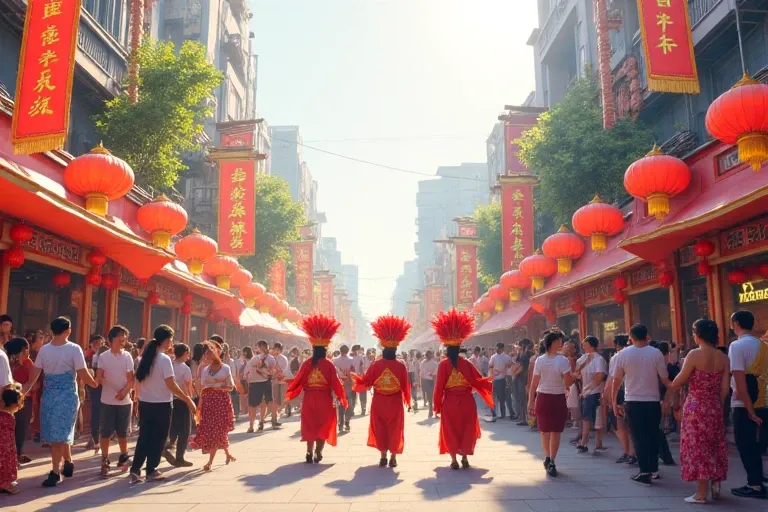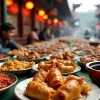Howdy, y'all! Your favorite American backpacking gourmand is back with another tale, this time from the heart of Guangdong, China. Forget your typical tourist traps; this time, I chased the elusive Nianli, a traditional New Year's celebration in southwest Guangdong, and let me tell you, it was a rollercoaster ride of cultural immersion, delicious food, and enough surprises to fill a year's worth of travel blogs. Prepare for a whirlwind tour of tradition, modernity, and the sheer, unadulterated fun of a genuinely unique cultural experience.
Zhanjiang's Urban Village: Where Millionaires Celebrate Nianli with Fireworks and Roasted Pig
My adventure started in Zhanjiang, in a city village so unexpected, it blew my mind. Picture this: high-rise buildings, self-built apartments stretching towards the sky, all nestled within a bustling urban environment. These weren't your typical rural homes; these were the opulent abodes of surprisingly wealthy villagers. Rental income from their multi-story buildings had transformed them into, dare I say, millionaires! The Nianli celebrations here were a fantastic clash of cultures. Traditional lion dances weaved through the streets, their vibrant colors a stark contrast to the sleek modern buildings, accompanied by the deafening crackle of fireworks – a joyful cacophony that resonated with the city’s energy. The air was thick with the mouthwatering aroma of roasted suckling pig, a culinary masterpiece that perfectly complemented the festive atmosphere. It was like a scene from a movie, only far more delicious and authentic. I even managed to snag a few red envelopes (lucky money!) from some incredibly generous locals. The sheer hospitality was overwhelming!
Table: Zhanjiang Urban Village Nianli – A Detailed Look
| Feature | Observation | Specific Details |
|---|---|---|
| Housing Type | High-rise self-built homes, significantly taller than surrounding structures. | Many converted into modern apartments and guesthouses, catering to both residents and urban professionals. |
| Nianli Activities | Lion dances, vibrant fireworks displays, family feasts centered around roasted suckling pig, red envelope exchanges. | Children enthusiastically participated, adding a layer of innocent joy to the festivities. |
| Economic Status of Residents | Remarkably affluent due to considerable rental income from their impressive properties. | Multi-million-dollar net worth is not uncommon among village residents. |
| Overall Impression | A mesmerizing contrast of traditional rural festivities and sophisticated urban development. | Demonstrates the evolving economic landscape of rural Guangdong, intertwined with ancient traditions. |
Po Tou Town's Nianli Parade: A Symphony of Color and Culture
Next, I journeyed to Po Tou Town, a short trip from Zhanjiang's city center. Here, the Nianli was not just a celebration; it was a full-blown spectacle! Imagine a parade of epic proportions, a breathtaking display of community spirit, and a vibrant tapestry of floats, traditional performances, and enough flags to blanket a small island. Fifteen villages united their resources to create this incredible event – the largest the town had ever seen, locals told me. Each village brought its unique flair to the procession, a rich tapestry of traditions interwoven with stunning visual artistry. I watched in awe as lion dancers leaped and twirled, their movements as fluid and graceful as the flowing silk of their costumes. The Piao Se (high-pole performances) were particularly breathtaking – a mesmerizing dance on seemingly unstable structures that defied gravity and instilled a sense of wonder. And the food? Oh, the food! Street vendors offered a dazzling array of local delicacies, a testament to the town’s culinary heritage. The energy was palpable; it was impossible not to be swept away by the jubilant atmosphere.
Table: Po Tou Town Nianli Parade – Key Observations and Insights
| Feature | Observation | Notable Details |
|---|---|---|
| Scale and Participation | Unprecedented scale and participation, uniting 15 villages in a unified celebration. | Each village showcased its unique cultural heritage, creating a spectacular diversity of traditions and performances. |
| Performances | Lion dances, elaborate floats, captivating Piao Se (high-pole performances), vibrant music, and enthusiastic crowds. | Local children participated actively, highlighting the importance of passing down traditions to the next generation. |
| Funding | Demonstrated the strong financial contribution from the villages, supporting performers, costumes, and elaborate displays. | This collaborative funding model underlines the significance of Nianli and the shared commitment of the community. |
| Modern Influences | Coexistence of modern businesses alongside the traditional celebrations. | The presence of international fast-food chains showcased the interaction between global trends and local traditions. |
Suixi County's Yingge Dance: A Rural Celebration of Heritage
My journey concluded in Suixi County, a rural haven quite distant from the vibrant cityscapes of Zhanjiang. I wanted to experience the true essence of Nianli away from the urban hustle and bustle. What I discovered was truly remarkable: a breathtaking performance by a 107-member Yingge dance troupe from Chaozhou. The energy was infectious, the costumes exquisite, and the skill of the dancers utterly captivating. The sheer magnitude of this rural event, in a county far removed from the major cities, demonstrated a deep dedication to cultural preservation. The dancers, some of whom had only been training for a few months, performed with such passion and precision, it was clear that this wasn't just a performance; it was a testament to their community’s unwavering commitment to tradition and the preservation of their cultural heritage. It was a truly humbling experience that solidified my appreciation for the profound impact of these celebrations on the heart of Chinese culture.
Table: Suixi County Nianli – The Yingge Performance
| Feature | Observation | Specifics |
|---|---|---|
| Dance Type | Yingge (a dynamic and visually stunning folk dance originating from Chaozhou) | Characterized by intricate footwork, vibrant costumes, and the use of various props. |
| Troupe Size | A large troupe of 107 dancers, showcasing exceptional coordination and skill. | The sheer scale of the performance was awe-inspiring. |
| Cultural Significance | Underscores the strong emphasis placed on the preservation of traditional arts in rural communities. | Highlighting the significant role that community engagement plays in keeping traditions alive. |
| Funding and Community Support | Extensive community support and investment demonstrated the high importance placed on this annual event. | The sizable financial commitment and dedication highlight the community's profound connection to their heritage. |
A Delicious Conclusion: More Than Just a Celebration
My Nianli adventure wasn’t just about parades and performances; it was a delicious, cultural immersion. From the succulent roasted suckling pig to the humble yet satisfying扣肉饭 (braised pork rice), every culinary experience enriched my understanding of Guangdong's culture. This journey showcased the fascinating blend of modernity and tradition, the stark economic contrasts between urban and rural areas, and most importantly, the unwavering commitment to preserving rich cultural heritage. Nianli is far more than just a festival; it is the beating heart of Guangdong's cultural identity, a vibrant and enduring testament to the enduring spirit of its people.ht colors and joyous atmosphere.







